Avocado Oil
Many early skin creams were described as skin foods. They were said to penetrate and feed the skin, plump it up, reduce wrinkles and generally make the face look younger. The ingredients in skin foods that ‘fed’ the skin were oils and fats with the best skin food generally considered to be lanolin, described as being ‘very penetrating’.
Animal fats and oils were believed to be better than those derived from plants because they were thought to be more readily absorbed by the skin. Some of these, such as fish and turtle oil, were also known to contain oil-soluble vitamins. The main problem with animal fats and oils was their odour which was often difficult to disguise in cosmetics, so new plant oils were always given due consideration.
See also: Skin Foods and Vitamin Creams
Avocados
The avocado Persea americana – old nomenclature: Persea gratissima – is a native of Central and South America. It was used by the Aztecs, Incas and Mayans as a food but they also spread the fruit pulp on their skin like a modern face mask. In the 1830s, avocado trees were introduced into Hawaii and Florida, then into California in the 1850s. However, it was not until the twentieth century that varieties suitable for commercial farming were developed in the United States (Schaffer & Whiley, 2012, p. 18) with California becoming the main fruit supplier.

Above: 1933 Avocado Show held in Whittier, California.

Above: Californian avocado groves.
In the 1920s, avocados were commonly known as ‘alligator pears’ but the American Pomological Society and the U.S. Department of Agriculture suggested that the more marketable name ‘avocado’ should be used (Popenoe, 1934, p. 109). The members of the California Avocado Association – originally established in 1915 as the California Ahuacate Association – eventually agreed to use the term avocado as well but trademarked the name ‘Calavo’ to distinguish Californian avocados from those grown elsewhere.
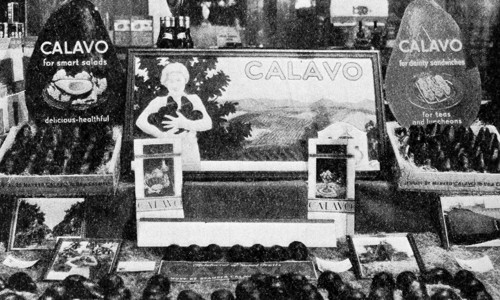
Above: 1932 Fresh Californian (Calavo) avocados on sale.
Early investigations
Selling fresh avocado fruits was the mainstay of the avocado industry in the United States but American growers tried to find other uses for scarred or blemished fruit that could not be sold in the whole fruit market, including the possibility of extracting avocado oil. Most of the research in this area was done by the United States Department of Agriculture and the California Avocado Association working in conjunction with various Californian universities.
It may be possible to utilize the cull[ed] avocado fruit, which at present goes to waste, by making use of the fatty oil contained in it. This oil probably would not find a market as an edible oil on account of its color, but experiments have shown that it would be valuable for the manufacture of soap.
(Jamieson, Baughman, & Hann, 1928, p. 204)
In the 1930s, extracting avocado oil was done by peeling the fruit, removing the seed, slicing and drying the fleshy portion of the fruit, and then extracting the oil by hydraulic pressure, or later by organic solvent (e.g., petroleum ether). This made the oil expensive to produce and, along with its green colour, convinced most investigators of the time that it would be not be suitable as a cooking or salad oil.
Cosmetics
One of the suggested uses for avocado oil was cosmetics and initial reports appeared promising. Apart from its green colour it compared very favourably with lanolin as it had good skin penetration, a high vitamin content, low odour, and excellent keeping qualities. It also produced finer emulsions when used in skin creams and lotions.
Among the properties of the oil which make it valuable as a cosmetic ingredient are the following: 1. It is one of the most penetrating oils known, rating with lanolin in its power to penetrate the skin tissue. It thus serves as a “carrier” for other valuable substances which lack penetrating power. This property makes it of value for use in tissue or nourishing creams, massage creams, all-purpose creams, massage oils (muscle oils) and other preparations where penetration and lubrication are essential. 2. Manufacturers who use Avocado oil in high grade toilet soaps attribute its superior lathering and cleansing properties to the oil. 3. Being rich in vitamins A and D (oil soluble), when properly prepared, it presents an advantage over most other vegetable or fruit oils available for cosmetic use [and] … avocados are a rich source of vitamins A, B, D, and E. … The oil has none of the objectionable odor of turtle or cod liver oils, which makes it suitable to replace these oils.
(Ball & Eaton, 1933, p. 365)
Avocado oil appears to be the exception to the general rule. Although a vegetable oil, it has high penetrative qualities and a high vitamin content. It is stated to contain vitamins A, D and E in addition to lecithin. The odour is only slight and would not be difficult to cover. In fact the oil appears to have all the desirable properties of a skin food, while having no undesirable ones, such as the unpleasant odour characteristic of turtle oil.
(Bushby, 1935, p. 183)
It would appear however that Avocado Pear oil has very “penetrating” properties, and that it also possesses the power of reducing surface tension with consequent production of a finer emulsion. In consequence of the above facts its use appears to be conducive to creams of a type less greasy, than with many other oils.
(Harry, 1940, p. 68)
Although avocado oil was more expensive to produce than many other vegetable oils, such as olive oil, researchers working for the California Avocado Association tried to put a positive spin on its high cost by suggesting that it would give skin creams a certain cachet.
The fact that Avocado oil is the highest priced oil used in cosmetics has proved of benefit to manufacturers who use the product, as it stamps their cosmetics as “quality” items.
(Ball & Eaton, 1933, p. 570)
Despite this attempt to give avocado oil an elite status most cosmetic firms that used the oil in the 1930s were small-time operations based close to avocado producing areas in the United States. Examples include: Ruth Rogers, Sara Cooley and Nason’s Avocado Cosmetics, all started in California; Sunclyme established in Florida; and Avocreme which began in Hawaii. The main exception to this rule was Coty which, in 1936, introduced an Avocado Soap and Avocado Beauty Milk using Calvalo (Californian) avocado oil.
Coty “Avocado” Beauty Milk
A Beauty treatment in itself!
It is a perfect cleanser. It is a deep tissue food. It is a perfect powder base. It incorporates, for the first time, the marvellous oil of the Avocado Pear. Use it regularly during Summer to care properly for your complexion.(Coty advertisement, 1936)
Also see the company booklet: The Secret of Coty Avocado Preparations and Coty
Post-war
The use of avocado oil in cosmetics increased in the second half of the twentieth century as supplies of avocados became more plentiful (both in the United States and elsewhere), more cost-effective extraction techniques were developed, and plant-based cosmetics and toiletries became more popular. Avocado oil’s high vitamin E content and emollient properties became increasingly appreciated when cosmetics made from ‘natural ingredients’ came into vogue in the 1970s. It was incorporated into a wide range of skin-care and hair-care products including hair conditioners, face creams, hand lotions and bath oils. For example, Coty’s Air Spun Avocado Skin Care range from the 1970s included Cleansing Creme, Freshener, Creme Moisturizer, Night Creme, Lotion toner, Milk Cleanser, Conditioning Moisturizer, Hand Creme and Nail Creme.
The properties that make Avocado oil an interesting cosmetic and soap constituent are as follows:
1. It is one of the most penetrating oils known and compares very favourably with lanolin in this respect. It is thus valuable in tissue and massage creams, muscle oils and other products where lubrication and penetration are essential.
2. Its high oil soluble vitamin content.
3. Its tendency to reduce the surface tension of liquids thus forming finer emulsions.
4. It has exhibited skin healing properties.
5. It is rich in lecithin and phytosterine.
6. Therapeutically, vegetable oil creams are more desirable than mineral oil creams and are more soothing to the skin.(Poucher, 1974, p. 45)
Avocado oil could be used in almost any cosmetic that used an oil in its formulation. However, replacing mineral oil with avocado oil – to make a cosmetic more ‘natural’ – generally required some adjustments to the proportions of other ingredients as using avocado oil would usually make an emulsion stiffer (Poucher, 1974, p. 46). An example recipe for a skin cream is given below:
AVOCADO OIL CREAM
Stearic Acid 14.0% Cocoa Butter 2.0% Cetyl Alcohol 0.5% Sorbitol 3.0% Avocado Oil 3.0% *Amino Glycol 1.5% Water 76.0% *2-Amino-2-Methyl-1,3-Propandiol
Melt the stearic acid, cocoa butter, cetyl alcohol, and avocado oil together in a separate container. Heat both of these containers to the same temperature, about 80°C., and pour the fat melt into the water mixture with mechanical agitation. Stir until the cream has cooled to room temperature.(Keithler, 1956, p. 96)
An earlier recipe for an Avocado Beauty Milk is as follows:
Avocado Oil 4.0 Tea seed oil 8.0 Stearic Acid 5.0 Triethanolamine 1.0 Mineral oil (viscosity 65/70) 8.0 Water 88.0 Perfume a sufficiency Apply with a small pledget of cotton, and allow it to remain on thr skin for some time. preferably overnight.
(The chemist and druggist, 1937, p. 412)
Using avocado pulp as a face mask – reproducing the ancient practice of the Aztecs, Incas and Mayans – also became a popular as a do-it-yourself home beauty treatment, a practice still recommended to this day.
Recent developments
Most avocado oil used in cosmetics in the late twentieth century was refined, bleached and deodorised, with the resulting product being an odourless, yellow oil. The introduction of cold-pressed avocado oil – first investigated in the 1980s but only becoming a commercial reality in the twenty-first century (Schaffer, Wolestenholme & Whiley, 2012, p. 525) – has opened up new possibilities for the oil, with virgin and extra virgin avocado oil now being sold as a culinary oil in supermarkets. It will be interesting to see how this development will affect its use in cosmetics, particularly in regard to the current vogue of applying natural oils directly to the skin.
Updated: 20th May 2018
Sources
Avocado oil in cosmetics. (1935). The Chemist and Druggist. March 16, 318.
Avocado oil: Preparation and properties. (1935). The Industrial Chemist Pharmaceutical and Cosmetic Supplement. July, 73.
Ball, R. N., & Eaton, R. F. (1933). Avocado oil in cosmetics. The Drug and Cosmetic Industry. 33(6), 535-536, 570.
Bushby, R. (1935). Avocado oil: Suggestions for its incorporation in skin foods. The Manufacturing Chemist. June, 183-184.
The chemist and druggist. (1937). April 3. London: Morgan Brothers.
Eaton, R. F., & Ball, R. N. (1934). Avocado oil in cosmetics. A new material, its properties and suggestions for its use. The American Perfumer and Essential Oil Review. June, 190-91.
Harry, R. G. (1940). Modern cosmeticology. The principles and practices of modern cosmetics. Brooklyn, NY: Chemical Publishing Company.
Jamieson, G. S., Baughman, W. F., & Hann, R. M. (1928). Avocado oil: The composition and constants of a little-known pericarp oil. Oil & Fat Industries. July, 202-207.
Keithler, W. M. R. (1956). The formulation of cosmetics and cosmetic specialties. New York: Drug and Cosmetic Industry.
Popenoe, W. (1934). Early history of the avocado California Avocado Association 1934 Yearbook. 19, 106-110.
Poucher, W. A. (1974). Perfumes, cosmetics and soaps (8th ed., Vol. 1). London: Chapman & Hall Ltd.
Schaffer, B., Wolestenholme, B. N., & Whiley, A. W. (Eds.). (2012). The avocado: Botany, production and uses (2nd ed.). Croydon, UK: CPI Group (UK) Ltd.
Webber, H. J. (1936). An early illustration of the avocado. California Avocado Association 1936 Yearbook. 21, 39-41.
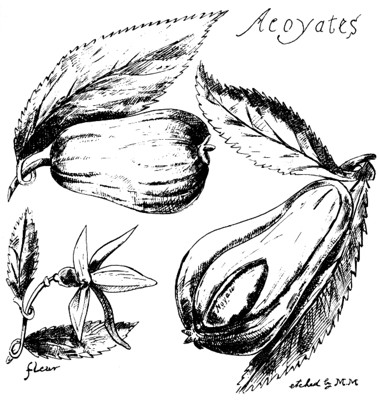
Drawing of acoyates (avocados) made around 1600 by Samuel Champlain (Webber, 1936).
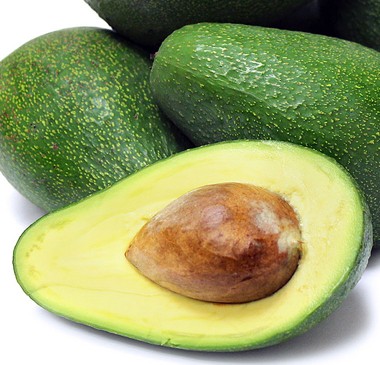
Fuete variety avocados.
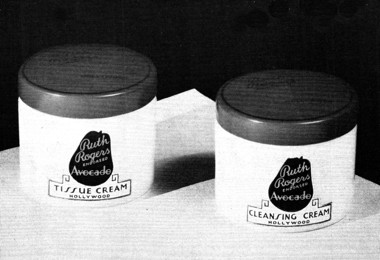
1933 Ruth Rogers Avocado Tissue Cream and Avocado Cleansing Cream.
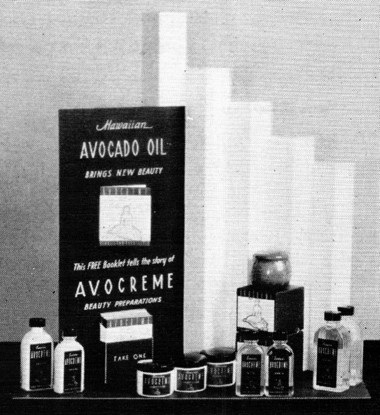
1934 Avocreme Co. of Hawaii, Ltd., Honolulu. In the past the company made food products. It used oil from its own avocado plantations to make cosmetics including several types of skin creams, a sunburn lotion, skin toner, liquid powder, shampoo, facial soap, brushless shave, hair oil, brilliantine, and sunburn oil.
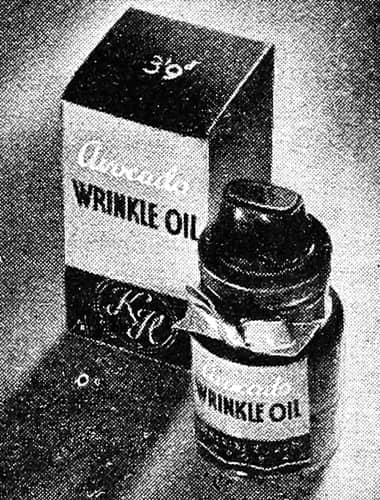
1935 Katherine Howard Avocado Wrinkle Oil, a British product.

1936 Coty Avocado Beauty Milk. Coty persisted with avocados for decades. For example, it introduced Avocado Cleansing Facial and Avocado Lemon Moisturiser into its range in the early 1970s.

1937 Sunclyme. There were four products in the line all based on tropical fruits: Lime and Lemon Cleansing Emollient to cleanse; Persian Lime Foundation Emulsion, to protect and apply a perfect make-up; Avocado Night Emollient, to lubricate; and Papaya Skin Tone, to tone and refine.
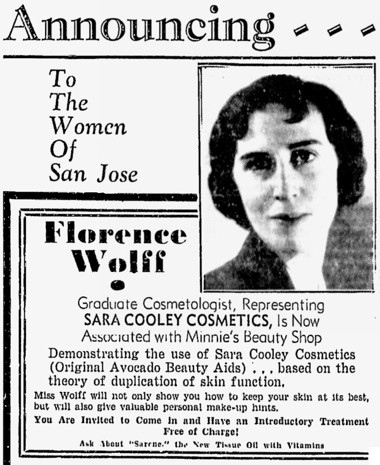
1937 Sarah Cooley Homogenized Tissue Cream for normal skins and Avovita for dry skins.
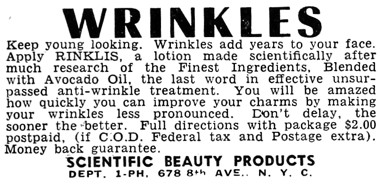
1945 Scientific Beauty Products Rinklis.
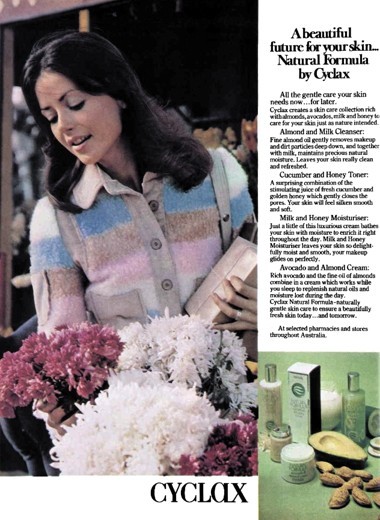
1974 Cyclax Natural Formula. A skin-care collection using a range of natural products including avocado oil.
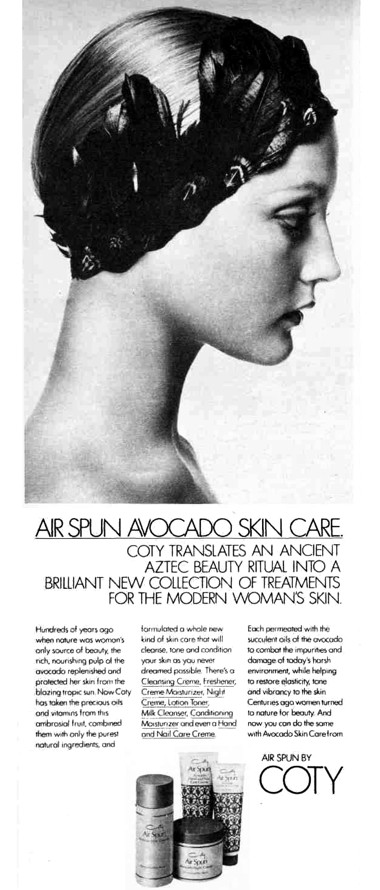
1974 Coty Air Spun Avocado Skin Care.
